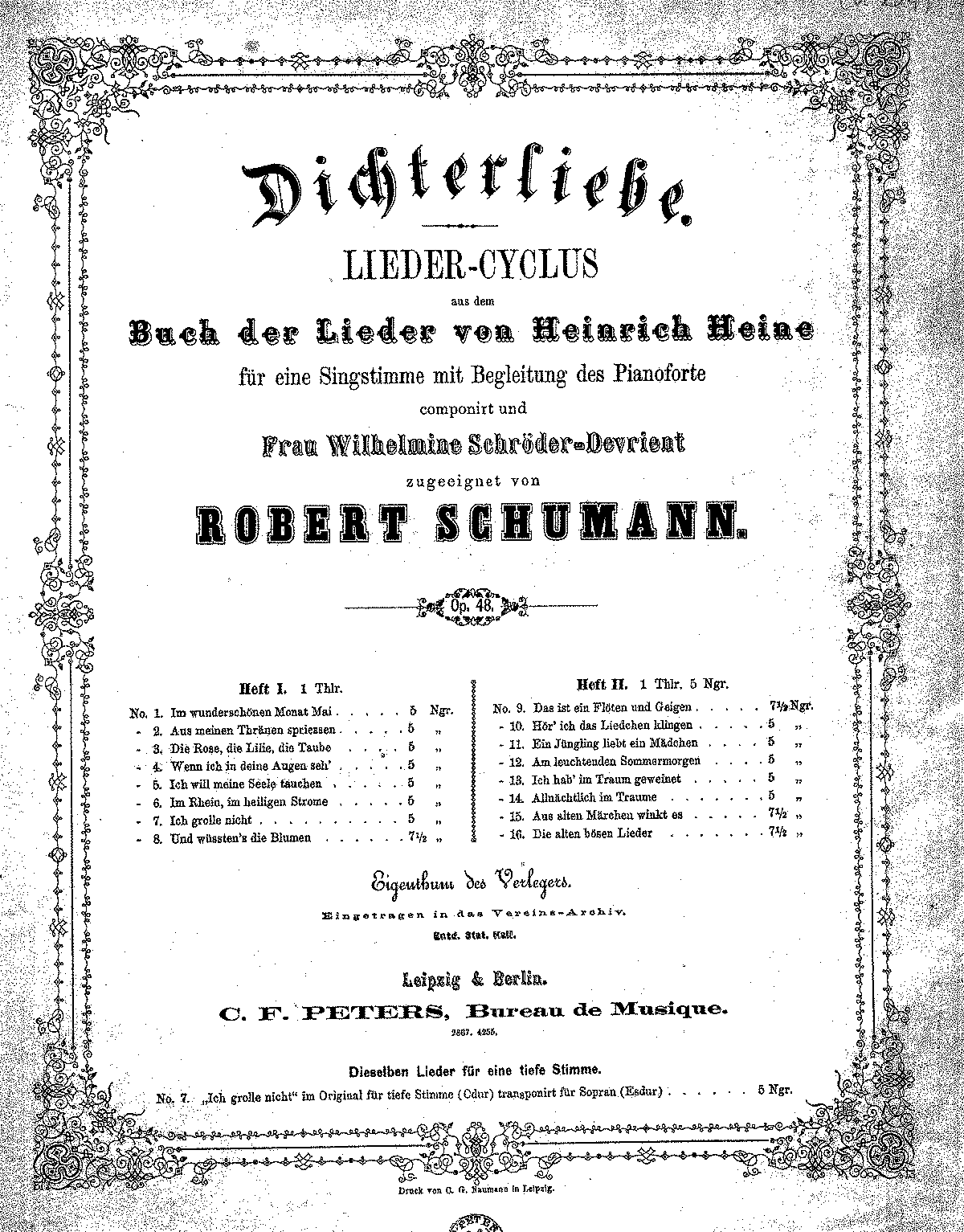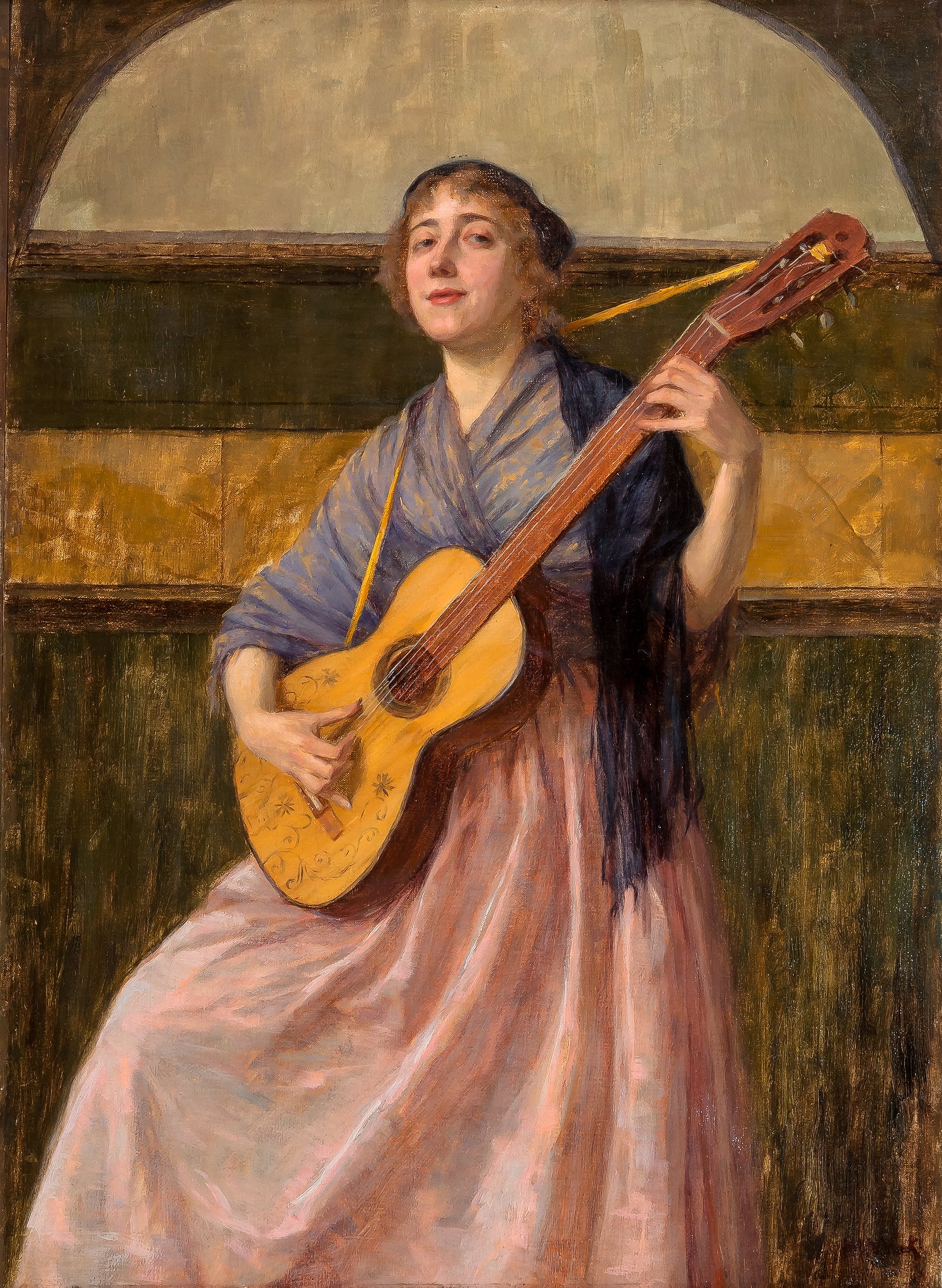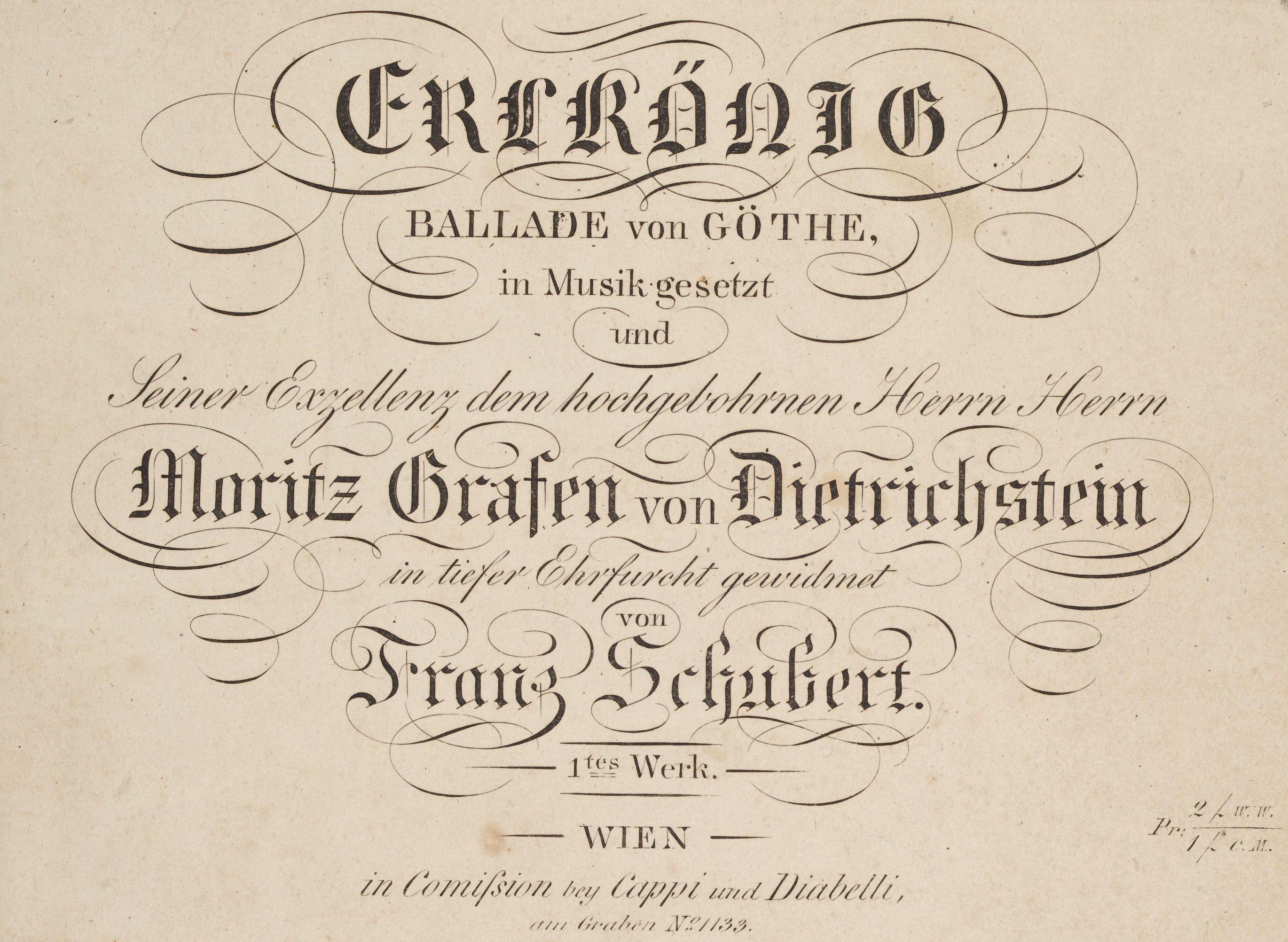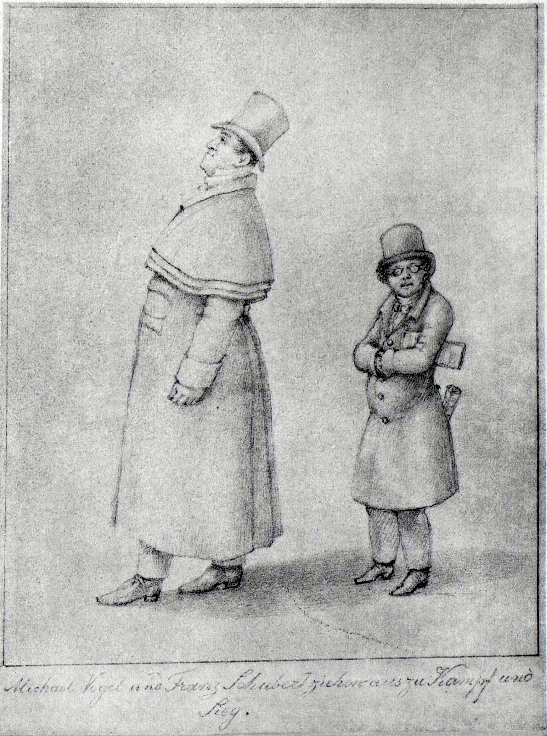|
Die Bürgschaft (Schubert)
"The Pledge" (German: "Die Bürgschaft", ) is a ballad published by the German poet Friedrich Schiller in his 1799 '' Musen-Almanach''. He took the idea out of the ancient legend of Damon and Pythias issuing from the Latin ''Fabulae'' by Gaius Julius Hyginus, as rendered in the medieval collection of the '' Gesta Romanorum''. It magnifies the belief in fidelity and loving friendship, and remains today one of the most famous German poems. Synopsis The ballad is set in the ancient Greek polis of Syracuse. After a failed attempt by Damon to kill the gruesome tyrant Dionysius, he is caught and sentenced to death but asks for a delay to marry his sister to her designated husband. Dionysius allows him an extension of three days on condition that his friend remains with him to guarantee Damon's return. If he would not be back on time, his friend would suffer his punishment, while Damon would go with impunity. To Dionysius' astonishment Damon, despite facing floods, an assault b ... [...More Info...] [...Related Items...] OR: [Wikipedia] [Google] [Baidu] |
Schiller Musenalmanach 1799 176
Johann Christoph Friedrich von Schiller (, short: ; 10 November 17599 May 1805) was a German playwright, poet, philosopher and historian. Schiller is considered by most Germans to be Germany's most important classical playwright. He was born in Marbach to a devoutly Protestant family. Initially intended for the priesthood, in 1773 he entered a military academy in Stuttgart and ended up studying medicine. His first play, ''The Robbers'', was written at this time and proved very successful. After a brief stint as a regimental doctor, he left Stuttgart and eventually wound up in Weimar. In 1789, he became professor of History and Philosophy at Jena, where he wrote historical works. During the last seventeen years of his life (1788–1805), Schiller developed a productive, if complicated, friendship with the already famous and influential Johann Wolfgang von Goethe. They frequently discussed issues concerning aesthetics, and Schiller encouraged Goethe to finish works that he had le ... [...More Info...] [...Related Items...] OR: [Wikipedia] [Google] [Baidu] |
Bertolt Brecht
Eugen Berthold Friedrich Brecht (10 February 1898 – 14 August 1956), known as Bertolt Brecht and Bert Brecht, was a German theatre practitioner, playwright, and poet. Coming of age during the Weimar Republic, he had his first successes as a playwright in Munich and moved to Berlin in 1924, where he wrote ''The Threepenny Opera'' with Elisabeth Hauptmann and Kurt Weill and began a life-long collaboration with the composer Hanns Eisler. Immersed in Marxist thought during this period, Brecht wrote didactic ''Lehrstücke'' and became a leading theoretician of epic theatre (which he later preferred to call "dialectical theatre") and the . When the Nazi Party, Nazis came to power in Germany in 1933, Brecht fled his home country, initially to Scandinavia. During World War II he moved to Southern California where he established himself as a screenwriter, while also being surveilled by the FBI. In 1947, he was part of the first group of Hollywood film artists to be subpoenaed by the Ho ... [...More Info...] [...Related Items...] OR: [Wikipedia] [Google] [Baidu] |
Lieder Composed By Franz Schubert
In the Western classical music tradition, ( , ; , ; ) is a term for setting poetry to classical music. The term is used for any kind of song in contemporary German and Dutch, but among English and French speakers, is often used interchangeably with "art song" to encompass works that the tradition has inspired in other languages as well. The poems that have been made into lieder often center on pastoral themes or themes of romantic love. The earliest ''Lieder'' date from the late fourteenth or early fifteenth centuries, and can even refer to from as early as the 12th and 13th centuries. It later came especially to refer to settings of Romantic poetry during the late eighteenth and nineteenth centuries, and into the early twentieth century. Examples include settings by Joseph Haydn, Wolfgang Amadeus Mozart, Ludwig van Beethoven, Franz Schubert, Robert Schumann, Johannes Brahms, Hugo Wolf, Gustav Mahler or Richard Strauss. History Terminology For German speakers, the te ... [...More Info...] [...Related Items...] OR: [Wikipedia] [Google] [Baidu] |
Poetry By Friedrich Schiller
Poetry (from the Greek language, Greek word ''poiesis'', "making") is a form of literature, literary art that uses aesthetics, aesthetic and often rhythmic qualities of language to evoke meaning (linguistics), meanings in addition to, or in place of, Denotation, literal or surface-level meanings. Any particular instance of poetry is called a poem and is written by a poet. Poets use a variety of techniques called poetic devices, such as assonance, alliteration, Phonaesthetics#Euphony and cacophony, euphony and cacophony, onomatopoeia, rhythm (via metre (poetry), metre), and sound symbolism, to produce musical or other artistic effects. They also frequently organize these effects into :Poetic forms, poetic structures, which may be strict or loose, conventional or invented by the poet. Poetic structures vary dramatically by language and cultural convention, but they often use Metre (poetry), rhythmic metre (patterns of syllable stress or syllable weight, syllable (mora) weight ... [...More Info...] [...Related Items...] OR: [Wikipedia] [Google] [Baidu] |
Ballads
A ballad is a form of verse, often a narrative set to music. Ballads were particularly characteristic of the popular poetry and song of Great Britain and Ireland from the Late Middle Ages until the 19th century. They were widely used across Europe, and later in Australia, North Africa, North America and South America. While ballads have no prescribed structure and may vary in their number of lines and stanzas, many ballads employ quatrains with ABCB or ABAB rhyme schemes, the key being a rhymed second and fourth line. Contrary to a popular conception, it is rare if not unheard-of for a ballad to contain exactly 13 lines. Additionally, couplets rarely appear in ballads. Many ballads were written and sold as single-sheet Broadside (music), broadsides. The form was often used by poets and composers from the 18th century onwards to produce lyrical ballads. In the later 19th century, the term took on the meaning of a slow form of popular love song and is often used for any love song ... [...More Info...] [...Related Items...] OR: [Wikipedia] [Google] [Baidu] |
List Of Compositions By Franz Schubert (D 1–D 500)
Franz Schubert (31 January 1797 – 19 November 1828), a Viennese composer of the late Classical to early Romantic eras, left a very extensive body of work notwithstanding his short life. He wrote over 1,500 items, or, when collections, cycles and variants are grouped, some thousand compositions. The largest group are his over six hundred Lieder for solo voice and piano. He composed nearly as many piano pieces, and further some 150 part songs, some 40 liturgical compositions (including several masses) and around 20 stage works like operas and incidental music. His orchestral output includes thirteen symphonies (seven completed) and several overtures. Schubert's chamber music includes over 20 string quartets, and several quintets, trios and duos. Otto Erich Deutsch compiled the first comprehensive catalogue of Schubert's works and published it in 1951 as '' Schubert: Thematic Catalogue of all his Works in Chronological Order''. A revised edition appeared in German in 1978. Lat ... [...More Info...] [...Related Items...] OR: [Wikipedia] [Google] [Baidu] |
Franz Schubert
Franz Peter Schubert (; ; 31 January 179719 November 1828) was an Austrian composer of the late Classical period (music), Classical and early Romantic music, Romantic eras. Despite his short life, Schubert left behind a List of compositions by Franz Schubert, vast ''oeuvre'', including more than 600 ''Lieder'' (art songs in German) and other vocal works, seven complete symphonies, sacred music, operas, incidental music, and a large body of piano and chamber music. His major works include "Erlkönig (Schubert), Erlkönig", "Gretchen am Spinnrade", and "Ave Maria (Schubert), Ave Maria"; the Trout Quintet, ''Trout'' Quintet; the Symphony No. 8 (Schubert), Symphony No. 8 in B minor (''Unfinished''); the Symphony No. 9 (Schubert), Symphony No. 9 in C major (''Great''); the String Quartet No. 14 (Schubert), String Quartet No. 14 in D minor (''Death and the Maiden''); the String Quintet (Schubert), String Quintet in C major; the Impromptus (Schubert), Impromptus for solo piano; the S ... [...More Info...] [...Related Items...] OR: [Wikipedia] [Google] [Baidu] |
Run, Melos!
is a Japanese Language, Japanese Novella, short story by Osamu Dazai. It was first published 1940 and is a widely read classic in Japanese schools. It was first used as teaching material for Japanese middle high schoolers in 1956. The story is a reworking of Friedrich Schiller's ballad ''Die Bürgschaft'', which tells the story of Melos and Selinuntius, originally Damon and Pythias. Schiller's version revolves around Damon and Pythias, an ancient Greek legend recorded by the Roman author Gaius Julius Hyginus. The most prominent theme of "Run, Melos!" is unwavering friendship. Despite hardships, the protagonist succeeds in saving his friend's life. Story Melos is a naive young shepherd with a sense of justice. He lives in a land ruled by Dionysius, a tyrant king who has killed many people, including his family members, due to his solitude and distrust of people. When Melos hears about the King's deeds, he is outraged, and he decides to assassinate the King. He sneaks into the ca ... [...More Info...] [...Related Items...] OR: [Wikipedia] [Google] [Baidu] |
Osamu Dazai
, known by his pen name , was a Japanese novelist and author. A number of his most popular works, such as ''The Setting Sun'' (斜陽, ''Shayō'') and '' No Longer Human'' (人間失格, ''Ningen Shikkaku''), are considered modern classics. His influences include Ryūnosuke Akutagawa, Murasaki Shikibu and Fyodor Dostoevsky. His last book, ''No Longer Human'', is his most popular work outside of Japan. Another pseudonym he used was Shunpei Kuroki (黒木 舜平), for the book ''Illusion of the Cliffs'' (断崖の錯覚, ''Dangai no Sakkaku''). Early life Shūji Tsushima was born on June 19, 1909, the eighth surviving child of a wealthy landowner and politician in Kanagi, located at the northern tip of the Tōhoku Region, in Aomori Prefecture. He was the tenth of the eleven children born to his parents. At the time of his birth, the huge, newly completed Tsushima mansion, where he spent his early years, was home to some thirty family members. The Tsushima family was of obscur ... [...More Info...] [...Related Items...] OR: [Wikipedia] [Google] [Baidu] |
Japan
Japan is an island country in East Asia. Located in the Pacific Ocean off the northeast coast of the Asia, Asian mainland, it is bordered on the west by the Sea of Japan and extends from the Sea of Okhotsk in the north to the East China Sea in the south. The Japanese archipelago consists of four major islands—Hokkaido, Honshu, Shikoku, and Kyushu—and List of islands of Japan, thousands of smaller islands, covering . Japan has a population of over 123 million as of 2025, making it the List of countries and dependencies by population, eleventh-most populous country. The capital of Japan and List of cities in Japan, its largest city is Tokyo; the Greater Tokyo Area is the List of largest cities, largest metropolitan area in the world, with more than 37 million inhabitants as of 2024. Japan is divided into 47 Prefectures of Japan, administrative prefectures and List of regions of Japan, eight traditional regions. About three-quarters of Geography of Japan, the countr ... [...More Info...] [...Related Items...] OR: [Wikipedia] [Google] [Baidu] |
Hanns Eisler
Hanns Eisler (6 July 1898 – 6 September 1962) was a German-Austrian composer. He is best known for composing the national anthem of East Germany, for his long artistic association with Bertolt Brecht, and for the scores he wrote for films. The Hochschule für Musik Hanns Eisler Berlin is named after him. Family background Johannes Eisler was born in Leipzig in Saxony, the third child of Rudolf Eisler, a professor of philosophy, and Marie Ida Fischer. His father was an atheist of Jewish descent and his mother was Lutheran of Swabian descent. In 1901, the family moved to Vienna. His older brother Gerhart was a Communist journalist, and his older sister Elfriede was a leader of the Communist Party of Germany in the 1920s. After emigrating to North America, she turned into an anti-Stalinist, his sister testified against him and his brother before the House Un-American Activities Committee. Early years As his family could not afford music lessons nor a piano, Eisler had to tea ... [...More Info...] [...Related Items...] OR: [Wikipedia] [Google] [Baidu] |
Golden Age
The term Golden Age comes from Greek mythology, particularly the ''Works and Days'' of Hesiod, and is part of the description of temporal decline of the state of peoples through five Ages of Man, Ages, Gold being the first and the one during which the Golden Race of humanity ( ''chrýseon génos'') lived. After the end of the first age was the Silver age, Silver, then the Bronze Age (mythology), Bronze, after this the Greek Heroic Age, Heroic age, with the fifth and current age being Iron Age (mythology), Iron. By extension, "Golden Age" denotes a period of primordial peace, harmony, ecological stability, stability, and prosperity. During this age, peace and harmony prevailed in that people did not have to work to feed themselves for the earth provided food in abundance. They lived to a very old age with a youthful appearance, eventually dying peacefully, with spirits living on as "guardians". Plato in ''Cratylus (dialogue), Cratylus'' (397 e) recounts the golden race of humans ... [...More Info...] [...Related Items...] OR: [Wikipedia] [Google] [Baidu] |










